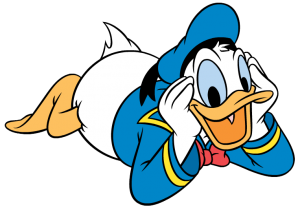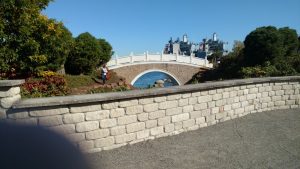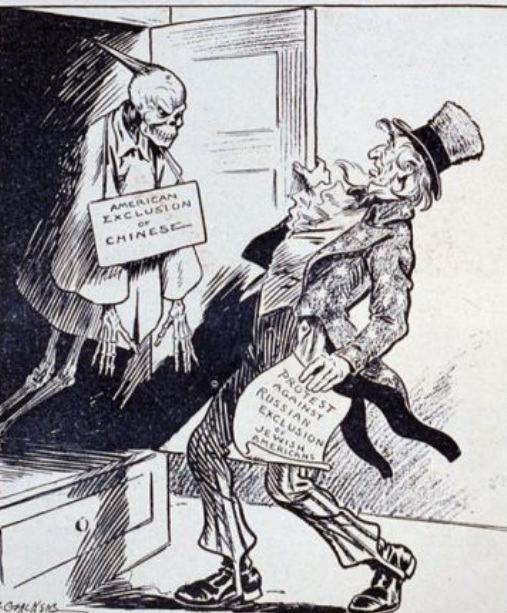For week 3, we moved from the previous topic of WWII Japanese-Americans to Chinese-Americans living in the modern-day time. In “Donald Duk”, a boy named Donald Duk absolutely despises his name, due to always being compared to the Disney character “Donald Duck”.

While his family poked fun at it in good jest, a majority of the jokes came from people making fun of his Chinese name, causing him to gradually hate his name more and more (as he went on about how much he hates it for the first two pages). Ironically, I found Donald Duk’s personality to be similar to the cartoon character’s; both are often jolly, but have a quick temper. Both are also often getting into trouble and acting overall immature. However, in the end, the jokes were used in a harmful way, affecting Donald’s viewpoint on Chinese people, as well as himself, in a negative way.
His school did not help in relieving this “hatred” about his Chinese heritage. In fact, Mr. Meanwright instead paints Chinese people as “passive”, “introverted”, and overall weak compared to the Americans. While Donald knows the oversimplification of these types of statements, he nonetheless feels embarrassed to be partially Chinese due to the fact that this is how typical white Americans view the Chinese, as well as Asians in-general. He doesn’t want to be viewed as weak, or passive, or even different. This is why he tries to push away Chinese culture: to try and be like a “normal” American.
Throughout the book, Donald struggles with his self-identity, not understanding who he truly is. He meets a few different characters in this path of self-discovery, even including people who are already long dead. By using his dreams, he learns more about how Chinese people worked very hard on the Union Pacific Railroad, only to have the white people take all the credit from them. The press even purposefully ignores the Chinese workers, not learning any of their names while asking Crocker for the names of the white, European workers. Going through all of this definitely helped Donald understand that there are many points in history where Asian accomplishments are covered up (to the point of his teacher not knowing the facts), and this slowly helped him become more proud of who he is, both is Chinese and his American side.
During our discussion in class, we brought up the theme of racism, and how the book describes some different types of racism, and how many of these does not make a person evil. For example, a little white after Donald starts having his dreams and realizing how white Americans treated the Chinese-Americans, he started to say things like “I hate white people.” This, in turn, offended his friend, Arnold, making him believe that Donald disliked him due to his race. Donald’s father later mentions how not all racism is meant as bad, and that people who spread purposeful hate upon a race are the bad racists. He describes how people can be racist due to their current society, and that they are doing it unconsciously. A great example of this is with Donald’s teacher, who asks for Donald’s input upon explaining false (or rather, oversimplified) information. He wants to learn and did not know that what he has been saying was discriminating against Chinese people. I really enjoyed the way we broke it down as racism vs. prejudice, defining the split between discrimination that is not on purpose vs. the discrimination that is. A good example of purposeful racism were The Big Four during Donald’s dreams. At the end of one chapter, when one of The Big Four explains that the Chinese were not a part of the company thus do not need the credit, another member states something along the lines of “… While I appreciate what they did, we will let the white men take credit.” (will add in actual line later), going on about how the “white” will be remembered. This is purposeful erasure of history, in an attempt to make white people look as though they had more of an impact on history than any other minor group.
There were also a lot of symbols for multiculturalism in the book, though there were three in particular that stood out to me: Lee Kuey; King’s restaurant; and the airplanes.
Lee Kuey was an odd character overall, having adverse effects of Agent Orange from back in the Vietnam War. Lee was just like Donald, wanting to push away his Chinese heritage and “become an American”, and I feel as though this was to show Donald of just what happens when one tries to push away who they really are; they suffer. Even Lee points out the similarity at the end of the second-to-last chapter, stating that he originally thought that Donald and him were very much alike, only for Donald to finally love himself for him.
King has traveled all over the world and has learned from the best cooks. However, one in particular stood out to him, being a Cantonese chef. This chef barely ever cooked actual Cantonese food, and instead cooked many foreign foods, to allow foreigners to feel like they are at home when eating his food (plus, they barely ever ordered Cantonese anyways). King was inspired by this, and so he established a restaurant that served a whole bunch of food as well, from American to Cantonese. This shows that a mix of cultures is not bad at all, and instead allows one to feel in their most comfortable state, as though they are “home”.
And finally, the airplanes. These were a very major symbol throughout the entire book, and it is understandable why. The planes represent Chinese culture, and Donald’s actions shows how he was feeling about himself. For example, when Donald lit the plane on fire, that represented Donald attempting to rid of his Chinese heritage, in his attempt to be “normal”. Later on, he is given another plane to build and replace for his father, showing him trying to put the pieces together and figure out who he really is. Later on, his mother also has another plane, and the two have a quick conversation about how Donald would only be able to build one plane within the next two weeks and that he should focus on one. I took this as one plane being his American heritage, while the other being his Chinese heritage. He needs to focus on figuring out if he wants to accept his Chinese background, rather than forcing himself to be “more American”. He should stop focusing on the American part, and instead build up his Chinese side.
Finally, at the end of the book, the plane is built, and this is when Donald finally accepts who he is. He has put all the pieces together, and now he has a sense of identity.
Like the last two, I really enjoyed reading this book; I feel like it definitely expanded my mind, opening up the discussion for many topics, such as racism and multiculturalism.



